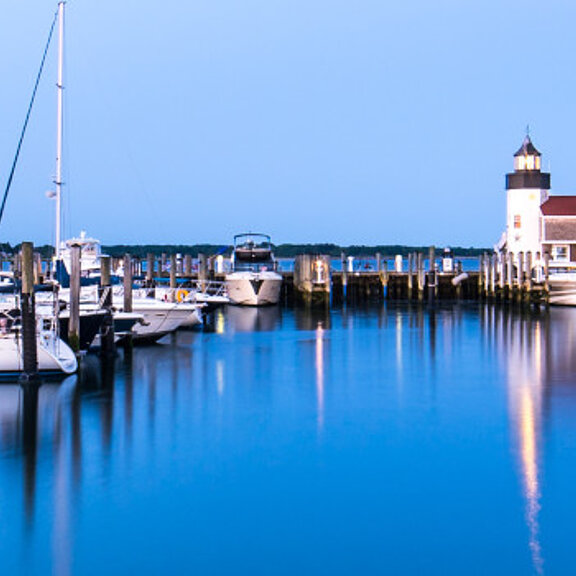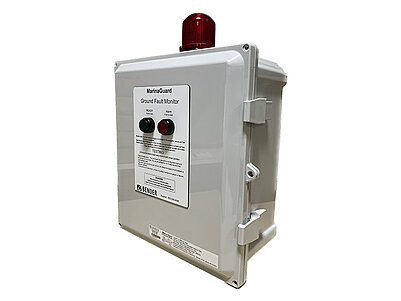

Electric shock drowning (ESD) can happen in any body of water. This is why Bender provides electrical safety solutions for marinas and harbors. Since marinas are typically equipped with electrical devices and services such as electrical outlets, shore power to boats, lighting, boat lifts, and more, they can be a hazard for people to experience ESD. Boats that are connected to marina shore power can also create an ESD hazard through defective onboard wiring. Electric shock drowning occurs when electric ground-fault current shocks nearby swimmers. If powerful enough, the shock will paralyze swimmers, leaving them unable to swim out of the water and away from the shock. Onlookers, attempting to aid the swimmer, can also fall victim to ESD.
Bender MarinaGuard® panels monitor for ground faults in the feeder and branch circuits supplying electricity to marinas, boatyards, docking facilities, floating buildings, and similar locations. If a ground fault is detected, the MarinaGuard trips the offending circuit and flashes a red strobe light to alert those nearby. The MarinaGuard panels satisfy the monitoring requirements of NEC Articles 555.35 and 682.15, and CE Code Rule 78-052.
Bender provides advanced ground-fault monitoring and protection systems to assist in the mitigation of ground faults and electric shock hazards for marinas. The power supply is tripped when a ground fault is detected, including when a boat connects to shore power. Monitoring capabilities can be provided anywhere from the main feeder to the individual pedestals and vessels. Low-level ground-fault current can be detected, even at the 'let-go' current level. Continuous monitoring with digital metering informs staff and technicians of ground fault issues, assisting in predictive maintenance.
MarinaGuard® panels are available with single-channel or twelve-channel monitoring from a single panel. Each circuit features an adjustable trip level to set below the maximum allowed, if desired. External current transformers are used to measure ground-fault current and are available in various sizes and shapes.
Senergy installed a Bender ground fault monitoring system at a new marina located in Winchester, TN.
“From start-up to commissioning of the entire system, the Bender support staff was onsite to assist with this task, which went flawlessly. Bender went through owner training, showing us and the owner what the system was capable of performing and how to navigate through all screens. The electrical inspector was very pleased with the system and operations, as were Senergy. We look forward to installing the Bender ground fault monitoring system on future marinas."
-Doug Sullivan, Project Manager - Senergy, LLC
While different states adopt new NEC editions at different times, the 2023 edition requires the following ground-fault protection of equipment for docking facilities:
Canadian provinces and territories adopt new CE Code editions at different times. The 2021 edition requires ground-fault protection for distribution equipment for docking facilities, fixed and floating piers, and boathouses:
Adjustable trip-current setting
Set the trip level at or below the maximum value. No need to replace units for different settings.
Adjustable trip-time setting
Coordinate trip times for layered protection systems to de-energize only the faulted circuit.
Automatic protection
Immediately remove an ESD hazard when a fault is detected.
Multiple circuit monitoring
Reduced installation time and complexity with the ability to monitor up to 12 circuits with a MarinaGuard® panel.
Maintain compliance
Compliance with the latest NEC and CE Code requirements for marina installations
| Name | Category | Size | Language | Timestamp | D-/B-Number |
|---|---|---|---|---|---|
| Marinas and Shore Power (US) | Market Segment Brochures | 3.2 MB | EN | 2023/05/0101.05.2023 | |
| 2020 Guidelines (US) | Technical Information | 1.9 MB | EN | 2020/06/1515.06.2020 | |
| Overview Brochure | Product Overviews | 10.3 MB | EN | 2023/10/0202.10.2023 | |
| Bender Industry Applications | Market Segment Brochures | 5.9 MB | EN | 2024/09/0404.09.2024 | |
| MarinaGuard® MG-1 | Manuals | 5.9 MB | EN | 2023/03/0909.03.2023 | |
| MarinaGuard® MG-1 | Datasheets | 719.7 KB | EN | 2023/03/1919.03.2023 | |
| MarinaGuard® MG-T | Manuals | 4.7 MB | EN | 2023/05/0101.05.2023 | |
| MarinaGuard® MG-T | Datasheets | 582.6 KB | EN | 2023/05/0101.05.2023 |
Products

Optimized for marinas, single and multi-channel Industrial Control Panels that shunt-trip external devices at mA protection levels

Optimized for marinas, single and multi-channel Industrial Control Panels that shunt-trip external devices at mA protection levels